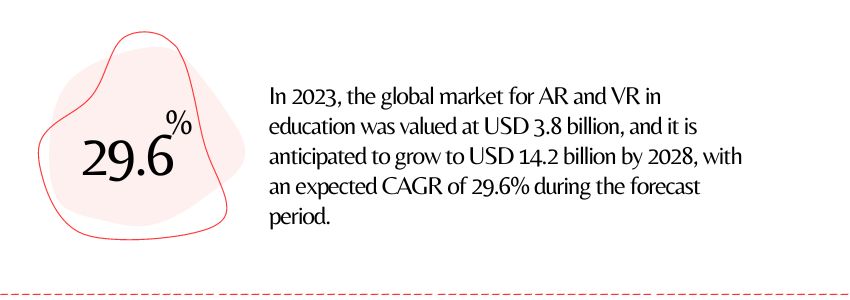With AR/VR, students can enter a virtual laboratory equipped with all necessary tools and chemicals. They can mix substances, observe real-time reactions, and even safely experience simulations of dangerous experiments.

AR/VR in Education
Enhanced Learning Experiences
AR and VR bring textbooks to life, enabling students to interact with 3D models and simulations. This hands-on approach enhances understanding and retention, making complex subjects more accessible and engaging.
Personalized Learning
With AR and VR, educators can customize learning experiences based on individual student needs. Adaptive learning algorithms analyze student interactions in real time, providing personalized feedback and adapting content to optimize learning outcomes.
Bridging Physical Gaps
Online education often lacks the physical presence of instructors and peers. AR and VR bridge this gap by creating virtual classrooms where students can collaborate, discuss, and learn together in a simulated environment, encouraging a sense of community and enhancing social interaction.
Practical Applications and Skill Development
In fields like medicine, engineering, and vocational training, AR and VR offer realistic simulations for hands-on practice. This practical application allows students to develop skills in a safe environment, significantly reducing the learning curve and preparing them for real-world challenges.
Accessibility and Inclusivity
AR and VR make education more accessible to students with disabilities. These technologies can adapt content for different learning styles and provide sensory experiences that accommodate diverse needs, ensuring equitable access to education.
AR/VR breaks down geographical barriers. Students from anywhere can join virtual field trips, explore historical sites, and experience diverse cultures, promoting inclusivity in education.
Cost-Efficiency and Scalability
Virtual classrooms powered by AR and VR reduce the need for physical infrastructure, such as classrooms and equipment. This scalability makes education more cost-effective, especially for institutions aiming to reach a broader audience without geographical constraints.
While AR/VR is still young, its impact on education is undeniable. AR/VR isn’t here to replace traditional online learning but to supercharge it. As these technologies become more affordable and widespread, we expect to see them play an even greater role in shaping the future of education, creating a more engaging, effective, and accessible learning experience for all.


